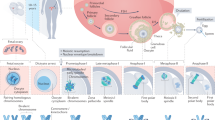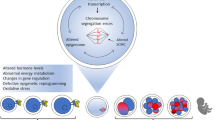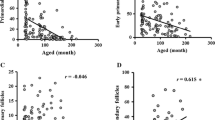Abstract
Correlations between maternal age and Down syndrome have been known already for over half a century (Penrose 1933; Bond and Chandley 1983). Still, the reasons for the dramatic increase in risks for a trisomic conceptus, spontaneous abortion associated with a chromosomally unbalanced embryo and the significantly reduced developmental potential of oocytes and embryos in aged women are unclear. Demographic analysis shows that there still is a trend for delaying childbearing to advanced maternal ages in many industrialized countries. Accordingly, it has been estimated that 25% of conceptions will involve women of 35 years or older in the Netherlands in 2005–2009 (te Velde and Pearson 2002). Many couples attending the infertility clinics are of advanced age. Therefore, it is important to investigate the origin of the maternal age-related decline in fertility associated with aneuploidy in oocytes in order to predict individual risks and, possibly, improve treatment. This contribution reviews briefly the current status of research on the incidence and the origin of aneuploidy in aged oocytes in humans and some experimental animals The observations suggest that prenatal events in oogenesis and recombination patterns influence susceptibility of chromosomes to errors in segregation, but that the depletion of the follicle pool, hormonal homeostasis, the oocyte-specific fragility of cohesion between homologues and permissive cell-cycle regulation at maturation may be important in the reduced quality of aged oocytes, which affects critically the fidelity of chromosome segregation and developmental potential.
Access this chapter
Tax calculation will be finalised at checkout
Purchases are for personal use only
Preview
Unable to display preview. Download preview PDF.
Similar content being viewed by others
References
Angell RR (1991) Predivision in human oocytes at meiosis I, a mechanism for trisomy formation in man. Hum Genet 86: 383–387
Angell R (1997) First-meiotic-division nondisjunction in human oocytes. Am J Hum Genet 61: 23–32
Battaglia DE, Goodwin P, Klein NA, et al (1996) Influence of maternal age on meiotic spindle assembly in oocytes from naturally cycling women. Mol Hum Reprod 11: 2217–2222
Benadiva CA, Kligman I, Munné S (1996) Aneuploidy 16 in human embryos increases significantly with maternal age. Fertil Steril 666: 248–255
Benzaken B, Martin-Pont B, Bergere M, et al (1998) Chromosome 21 detection in human oocyte fluorescence in situ hybridization possible effect of maternal age. J Ass Reprod Genet 15: 105–110
Bhal PS, Pugh ND, Gregory L, et al (2001) Perifollicular vascularity as a potential variable affecting outcome in stimulated intrauterine insemination treatment cycles: a study using transvaginal power Doppler. Hum Reprod 16: 1682–1689
Bond DJ, Chandley AC (1983) Aneuploidy. Oxford monographs on medical genetics No. 11. Oxford University Press, Oxford
Brook JD, Gosden RG, Chandley AC (1984) Maternal age and aneuploid embryos: evidence from the mouse that biological and not chronological age is the important influence. Hum Genet 6: 41–45
Brown AS, Feingold E, Broman KW, et al (2000) Genome-wide variation in recombination in female meiosis: a risk factor for non-disjunction of chromosome 21. Hum Mol Genet 9: 515–523
Brunet S, Maria AS, Guillaud P, et al (1999) Kinetochore fibers are not involved in the formation of the first meiotic spindle in mouse oocytes, but control the exit from the first meiotic M phase. J Cell Biol 146: 1–12
Buonomo SB, Clyne RK, Fuchs J et al (2000) Disjunction of homologous chromosomes in meiosis I depends on proteolytic cleavage of the meiotic cohesin Rec8 by separin. Cell 103: 387–398
Bugge M, Collins A, Peterson M, et al (1998) Non-disjunction of chromosome 18. Hum Mol Genet 7: 661–669
Caligara C, Navarro J, Vargas G et al (2001) The effect of repeated controlled ovarian stimulation in donors. Hum Reprod 16: 2320–2323
Carabatsos MJ, Sellitto C, Goodenough DA, et al (2000) Oocyte-granulosa cell heterologous gap junctions are required for the coordination of nuclear and cytoplasmic meiotic competence. Dev Biol 226: 167–179
Clyde JM, Gosden RG, Rutherford AJ, et al (2001) Demonstration of a mechanism of aneuploidy in human oocytes using Multifluor fluorescence in situ hybridization. Fertil Steril 76: 837–840
Coulam CB, Goodman C, Rinehart JS (1999) Colour Doppler indices of follicular blood flow as predictors of pregnancy after in-vitro fertilization and embryo transfer. Hum Reprod 14: 1979–1982
Crowley PH, Gulati DK, Hayden TL, et al (1979) A chiasma-hormonal hypothesis relating Down’s syndrome and maternal age. Nature 280: 417–418
Dailey T, Dale B, Cohen J, et al (1996) Association between nondisjunction and maternal age in meiosis-II human oocytes. Am J Hum Genet 59: 176–184
De La Fuente R, Eppig JJ (2001) Transcriptional activity of the mouse oocyte genome: companion granulosa cells modulate transcription and chromatin remodeling. Dev Biol 229: 224–236
Delhanty JD, Harper JC, Ao A, et al (1997) Multicolour FISH detects frequent chromosomal mosaicism and chaotic division in normal preimplantation embryos from fertile patients. Hum Genet 99: 755–760
Eichenlaub-Ritter U (1996) Parental age-related aneuploidy in human germ cells and offspring: a story of past and present. Environ Mol Mutagen 28: 211–236
Eichenlaub-Ritter U (1998) Genetics of oocyte ageing. Maturitas 30: 143–169
Eichenlaub-Ritter U (2000) The determinants of non-disjunction and their possible relationship with oocyte ageing. In: te Velde ER, Pearson PL, Broekmans FJ (eds) Studies in profertility series 9: female reproductive aging. Parthenon, New York, pp 149–184
Eichenlaub-Ritter U, Boll I (1989) Nocodazole sensitivity, age-related aneuploidy, and alterations in the cell cycle during maturation of mouse oocytes. Cytogenet Cell Genet 52: 170–176
Eichenlaub-Ritter U, Peschke M (2002) Expression in in vivo and in vitro growing and maturing oocytes: focus on regulation of expression at the translational level. Hum Reprod Update (in press)
Eichenlaub-Ritter U, Chandley AC, Gosden RG (1988) The CBA mouse as a model for age-related aneuploidy in man: studies of oocyte maturation, spindle formation and chromosome alignment during meiosis. Chromosoma 96: 220–226
Fabricant JD, Schneider E (1978) Studies on the genetic and immunologic components of the maternal age effect. Dev Biol 66: 41–45
Faddy MJ (2000) Follicle dynamics during ovarian ageing. Mol Cell Endocrinol 163: 43–48
Freeman SB, Yang Q, Allran K (2000) Women with a reduced ovarian complement may have an increased risk for a child with Down syndrome. Am J Hum Genet 66: 1680–1683
Fritz B, Hallermann C, Olert J, et al (2001) Cytogenetic analyses of culture failures by comparative genomic hybridisation ( CGH)-Re-evaluation of chromosome aberration rates in early spontaneous abortions. Eur J Hum Genet 9: 539–547
Fulka J Jr, Jung T, Moor RM (1992) The fall of biological maturation promoting factor (MPF) and histone H1 kinase activity during anaphase and telophase in mouse oocytes. Mol Reprod Dev 32: 378–382
Gardner RD, Burke DJ (2000) The spindle checkpoint: two transitions, two pathways. Trends Cell Biol 10: 154–218
Gaulden ME (1992) Maternal age-effect: the enigma of Down syndrome and other trisomie conditions. Mutation Res 296: 69–88
Gianaroli L, Magli MC, Ferraretti AP, et al (1999) Preimplantation diagnosis for aneuploidies in patients undergoing in vitro fertilization with a poor prognosis: identification of the categories for which it should be proposed. Fertil Steril 72: 837–844
Gosden RG (1973) Chromosome anomalies of preimplantation mouse embryos in relation to maternal age. J Reprod Fertil 35: 351–354
Gras L, McBain J, Trounson A, et al (1992) The incidence of chromosomal aneuploidy in stimulated and unstimulated [natural] uninseminated human oocytes. Hum Reprod 7: 1396–1401
Harrison RH, Kuo HC, Scriven PN (2000) Lack of cell cycle checkpoints in human cleavage stage embryos revealed by a clonal pattern of chromosomal mosaicism analysed by sequential multicolour FISH. Zygote 8: 217–224
Hassold TJ (1998) Nondisjunction in the human male. Curr Topics Dev Biol 37: 383–406
Hassold T, Hunt P (2001) To err (meiotically) is human: the genesis of human aneuploidy. Nat Rev Genet 2: 280–291
Hassold TJ, Sherman SL, Pettay D, et al (1991) XY chromosome nondisjunction in man is associated with diminished recombination in the pseudoautosomal region. Am J Hum Genet 49: 253–260
Hassold TJ, Merrill M, Adkins K, et al (1995) Recombination and maternal age-related non-disjunction: molecular studies of trisomy 16. Am J Hum Genet 57: 867–874
Hassold T, Sherman S, Hunt P (2000) Counting cross-overs: characterizing meiotic recombination in mammals. Hum Mol Genet 9: 2409–2419
Henderson SA, Edwards RG (1968) Chiasma frequency and maternal age in mammals. Nature 217: 22–28
Hodges CA, LeMaire-Adkins R, Hunt PA (2001) Coordinating the segregation of sister chromatids during the first meiotic division: evidence for sexual dimorphism. J Cell Sci 114: 2417–2426
Iwarsson E, Lundqvist M, Inzunza J, et al (1999) A high degree of aneuploidy in frozen-thawed human preimplantation embryos. Hum Genet 104: 376–382
Jamieson ME, Coutts JR, Connor JM (1994) The chromosome constitution of human preimplantation embryos fertilized in vitro. Mol Hum Reprod 9: 709–715
Keefe DL, Niven-Fairchild T, Powell S, et al (1995) Mitochondrial deoxyribonucleic acid deletions in oocytes and reproductive aging in women. Fertil Steril 64: 577–583
Kline J, Kinney A, Levin B, et al (2000) Trisomic pregnancy and earlier age at menopause. Am J Hum Genet 67: 395–404
Koehler KE, Hawley RS, Sherman S, et al (1996) Recombination and nondisjunction in humans and flies. Hum Mol Genet 5: 1495–1504
Lamb NE, Freeman SB, Savage-Austin A, et al (1996) Susceptible chiasmate configurations of chromosome 21 predispose to non-disjunction in both maternal meiosis I and meiosis II. Nat Genet 14: 400–405
Lamb NE, Feingold E, Savage A, et al (1997) Characterization of susceptible chiasma configurations that increase the risk for maternal nondisjunction of chromosome 21. Hum Mol Genet 6: 1391–1399
Ledan E, Polanski Z, Tenet ME (2001) Meiotic maturation of the mouse oocyte requires an equilibrium between cyclin B synthesis and degradation. Dev Biol 232: 400–413
Lee JY, Orr-Weaver TL (2001) The molecular basis of sister-chromatid cohesion. Annu Rev Cell Dev Biol 17: 753–777
LeMaire-Adkins E, Radke K, Hunt PA (1997) Lack of checkpoint control at the metaphase-anaphase transition: a mechanism of meiotic non-disjunction in mammalian females. J Cell Biol 139: 1611–1619
LeMaire-Adkins R, Hunt PA (2000) Nonrandom segregation of the mouse univalent X chromosome: evidence of spindle-mediated meiotic drive. Genetics 156: 775–783
Libby BJ, De La Fuente R, O’Brien MJ, et al (2002) The mouse meiotic mutation mei 1 disrupts chromosome synapsis with sexually dimorphic consequences for meiotic progression. Dev Biol 242: 174–187
Lu Q, Dunn RL, Angeles R, et al (2002) Regulation of spindle formation by active mitogen-activated protein kinase and protein phosphatase 2 a during mouse oocyte meiosis. Biol Reprod 66: 29–37
MacDonald M, Hassold TJ, Harvey J (1994) The origin of 47,XXY and 47,XXX aneuploidy: heterogeneous mechanisms and role of aberrant recombination. Hum Mol Genet 3: 1365–1371
Mahmood R, Brierley CH, Faed MJ, et al (2000) Mechanisms of maternal aneuploidy: FISH analysis of oocytes and polar bodies in patients undergoing assisted conception. Hum Genet 106: 620–626
Mailhes JB, Young D, London SN (1998) Postovulatory ageing of mouse oocytes in vivo and premature centromere separation and aneuploidy. Biol Re-prod 58: 1206–1210
Marquez C, Cohen J, Munné S (1998) Chromosome identification in human oocytes and polar bodies by spectral karyotyping. Cytogenet Cell Genet 81: 254–258
Marquez C, Sandalinas M, Bahçe M, et al (2000) Chromosome abnormalities in 1255 cleavage-stage human embryos. Reprod Biomed Online 1: 17–27
Martini E, Flaherty SP, Swann NJ (2000) FISH analysis of six chromosomes in unfertilized human oocytes after polar body removal. J Assist Reprod Genet 17: 276–283
Mitra J, Schultz RM (1996) Regulation of the acquisition of meiotic competence in the mouse: changes in the subcellular localization of cdc2, cyclin B1, cdc25 C and weel, and in the concentration of these proteins and their transcripts. J Cell Sci 109: 2407–2415
Muller-Hocker J, Schafer S, Weis S, et al (1996) Morphological-cytochemical and molecular genetic analyses of mitochondria in isolated human oocytes in the reproductive age. Mol Hum Reprod 2: 951–958
Munné S, Cohen J (1998) Chromosome abnormalities in human embryos. Hum Reprod Update 4: 842–855
Nakaoka Y, Okamoto E, Miharu N. et al (1998) Chromosome analysis in human oocytes remaining unfertilized after in-vitro insemination: effect of maternal age and fertilization rate. Hum Reprod 13: 419–424
Nasmyth K (2001) Disseminating the genome: joining, resolving, and separating sister chromatids during mitosis and meiosis. Annu Rev Genet 35: 673–745
Nicklas RB, Waters JC, Salmon ED, et al (2001) Checkpoint signals in grasshopper meiosis are sensitive to microtubule attachment, but tension is still essential. J Cell Sci 114: 4173–4183
Parisi S, McKay MJ, Molnar M, et al (1999) Recap, a meiotic recombination and sister chromatid cohesion phosphoprotein of the Rad2lp family is conserved from fission yeast to humans. Mol Cell Biol 19: 3515–3528
Penrose LS (1933) The relative effects of paternal and maternal age in mongolism. J Genet 27: 219–224
Plachot M (2001) Chromosomal abnormalities in oocytes. Mol Cell Endocrinol 183 (Suppl 1): S59–S63
Polani PE, Crolla JA (1981) A test of the production line hypothesis of mammalian oogenesis. Hum Genet 88: 64–70
Rieder CL, Schultz A, Cole R, et al (1994) Anaphase onset in vertebrate somatic cells is controlled by a checkpoint that monitors sister kinetochore attachment to the spindle. J Cell Biol 127: 1301–1310
Robinson WP, Kuchinka, B., Bernasconi F, et al (1998) Maternal meiosis I non-disjunction of chromosome 15: dependence of the maternal age effect on level of recombination. Hum Mol Genet 7: 1011–1019
Roeder GS, Bailis JM (2000) The pachytene checkpoint. Trends Genet 16: 395–403
Sakurada K, Ishikawa H, Endo A (1996) Cytogenetic effects of advanced maternal age and delayed fertilization on first-cleavage mouse embryos. Cytogenet Cell Genet 72: 46–49
Schon EA, Kim SH, Ferreira JC, et al (2000) Chromosomal non-disjunction in human oocytes: is there a mitochondrial connection? Hum Reprod 15 (Suppl 2): 160–172
Sears DD, Hegemann JH, Hieter P (1992) Meiotic recombination and segregation of human-derived artificial chromosomes in Saccharomyces cerevisiae. Proc Natl Acad Sci USA 89: 5296–5300
Shonn MA, McCarroll R, Murray AW (2000) Requirement of the spindle checkpoint for proper chromosome segregation in budding yeast meiosis. Science 289: 300–303
Soewarto D, Schmiady H, Eichenlaub-Ritter U (1995) Consequences of non-extrusion of the first polar body and control of the sequential segregation of homologues and chromatids in mammalian oocytes. Hum Reprod 10: 2350–2360
Steuerwald N, Cohen J, Herrera RJ, et al (2001) Association between spindle assembly checkpoint expression and maternal age in human oocytes. Mol Hum Reprod 7: 49–55
Sudakin V, Chan GK, Yen TJ (2001) Checkpoint inhibition of the APC/C in HeLa cells is mediated by a complex of BUBR1, BUB3, CDC20, and MAD2. J Cell Biol 154: 925–936
Sugawara S, Mikamo K (1983) Absence of correlation between univalent formation and meiotic nondisjunction in aged female Chinese hamsters. Cytogenet Cell Genet 35: 34–40
Sun F, Yin H, Eichenlaub-Ritter U (2001) Differential chromosome behaviour in mammalian oocytes exposed to the tranquilizer diazepam in vitro. Mutagenesis 16: 407–417
Tarin JJ (1996) Potential effects of age-associated oxidative stress on mammalian oocytes/embryos. Mol Hum Reprod 2: 717–724
Tay J, Richter JD (2001) Germ cell differentiation and synaptonemal complex formation are disrupted in CPEB knockout mice. Dev Cell 1: 201–213
Velde E, Pearson P (2002) The variability of female reproductive ageing. Hum Reprod Update 8: 141–154
Toth A, Rabitsch KP, Galova M (2000) Functional genomics identifies monopolin: a kinetochore protein required for segregation of homologs during meiosis I. Cell 103: 1155–1168
Blerkom J (2000) Intrafollicular influences on human oocyte developmental competence: perifollicular vascularity, oocyte metabolism and mitochondrial function. Hum Reprod 15 (Suppl 2): 173–188
Blerkom J, Davis P (2001) Differential effects of repeated ovarian stimulation on cytoplasmic and spindle organization in metaphase II mouse oocytes matured in vivo and in vitro. Mol Hum Reprod 16: 757–764
Vaskivuo TE, Anttonen M, Herva R, et al (2001) Survival of human ovarian follicles from fetal to adult life: apoptosis, apoptosis-related proteins, and transcription factor GATA-4.Clin Endocrinol Metab 86: 3421–3429.
Verlhac MH, Kubiak J, Clarke HJ, et al (1994) Microtubule and chromatin behaviour follow MAP kinase activity but not MPF during meiosis in mouse oocytes. Development 120: 1017–1025
Verlinsky Y, Cieslak J, Ivakhnenko V, et al (2001) Chromosomal abnormalities in the first and second polar body. Mol Cell Endocrinol 183 (Suppl 1): S47–S49
Volarcik K, Sheean L, Goldfarb J, et al (1998) The meiotic competence of human oocytes is influenced by donor age: evidence that folliculogenesis is compromised in the reproductively aged ovary. Hum Reprod 13: 154–160
Warburton D, Kinney A (1996) Chromosomal differences in suceptibility to meiotic aneuploidy. Environ Mol Mutagen 28: 237–247
Wells D, Delhanty JD (2000) Comprehensive chromosomal analysis of human preimplantation embryos using whole genome amplification and single cell comparative genomic hybridization. Mol Hum Reprod 6: 1055–1062
Wilding M, Dale B, Marino M, et al (2001) Mitochondrial aggregation patterns and activity in human oocytes and preimplantation embryos. Hum Re-prod 16: 909–917
Wolstenholme J, Angell RR (2000) Maternal age and trisomy — a unifying mechanism of formation. Chromosoma 109: 435–438
Woods LM, Hodges CA, Baart E, et al (1999) Chromosomal influence on meiotic spindle assembly: abnormal meiosis I in female Mlhl mutant mice. J Cell Biol 145: 1395–1406
Wu J, Zhang L, Wang X (2000) Maturation and apoptosis of human oocytes in vitro are age-related. Fertil Steril 74: 1137–1141
Zuccotti M, Boiani M, Garagna S (1998) Analysis of aneuploidy rate in antral and ovulated mouse oocytes during female aging. Mol Reprod Dev 50: 305–331
Editor information
Editors and Affiliations
Rights and permissions
Copyright information
© 2002 Springer-Verlag Berlin Heidelberg
About this paper
Cite this paper
Eichenlaub-Ritter, U. (2002). Ageing and Aneuploidy in Oocytes. In: Eppig, J., Hegele-Hartung, C., Lessl, M. (eds) The Future of the Oocyte. Ernst Schering Research Foundation Workshop, vol 41. Springer, Berlin, Heidelberg. https://doi.org/10.1007/978-3-662-04960-0_8
Download citation
DOI: https://doi.org/10.1007/978-3-662-04960-0_8
Publisher Name: Springer, Berlin, Heidelberg
Print ISBN: 978-3-662-04962-4
Online ISBN: 978-3-662-04960-0
eBook Packages: Springer Book Archive




